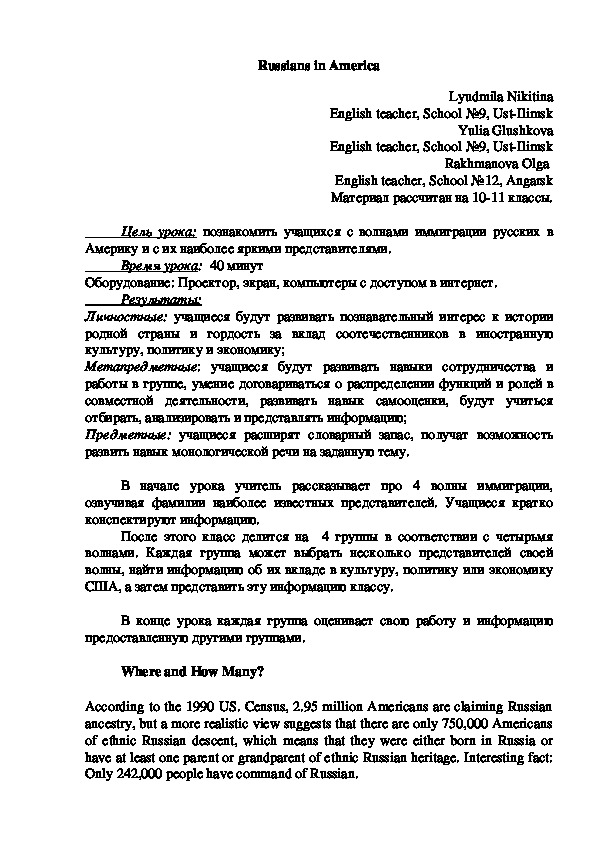Презентация по английскому языку для 10-11 классов по теме "Русская реплика в США"
Презентации учебные
docx
английский язык +1
10 кл—11 кл +1
01.04.2017

Публикация является частью публикации:
Никитина ЛА ПРОЕКТ Russians in America Никитина Л.А..docx
Russians in America
Lyudmila Nikitina
English teacher, School №9, UstIlimsk
Yulia Glushkova
English teacher, School №9, UstIlimsk
Rakhmanova Olga
English teacher, School №12, Angarsk
Материал рассчитан на 1011 классы.
Время урока: 40 минут
Результаты:
Цель урока: познакомить учащихся с волнами иммиграции русских в
Америку и с их наиболее яркими представителями.
Оборудование: Проектор, экран, компьютеры с доступом в интернет.
Личностные: учащиеся будут развивать познавательный интерес к истории
родной страны и гордость за вклад соотечественников в иностранную
культуру, политику и экономику;
Метапредметные: учащиеся будут развивать навыки сотрудничества и
работы в группе, умение договариваться о распределении функций и ролей в
совместной деятельности, развивать навык самооценки, будут учиться
отбирать, анализировать и представлять информацию;
Предметные: учащиеся расширят словарный запас, получат возможность
развить навык монологической речи на заданную тему.
В начале урока учитель рассказывает про 4 волны иммиграции,
озвучивая фамилии наиболее известных представителей. Учащиеся кратко
конспектируют информацию.
После этого класс делится на 4 группы в соответствии с четырьмя
волнами. Каждая группа может выбрать несколько представителей своей
волны, найти информацию об их вкладе в культуру, политику или экономику
США, а затем представить эту информацию классу.
В конце урока каждая группа оценивает свою работу и информацию
предоставленную другими группами.
Where and How Many?
According to the 1990 US. Census, 2.95 million Americans are claiming Russian
ancestry, but a more realistic view suggests that there are only 750,000 Americans
of ethnic Russian descent, which means that they were either born in Russia or
have at least one parent or grandparent of ethnic Russian heritage. Interesting fact:
Only 242,000 people have command of Russian. Waves of Immigration
The First Wave: Freedom from religious persecution.
The first wave of mass immigration from Russia and Eastern Europe took place in
the second half of the nineteenth century and early twentieth century before World
War I.
The majority of those arriving were Jews. Many Russian Jews settled in New York
and other large American coastal cities. Other immigrants included Russian
religious pacifist groups that were in conflict with the Russian Orthodox Church.
1. Alexander Andreyevich Baranov was born in 1746 in Kargopol. Alexander ran
away from home at the age of fifteen. He became a successful merchant in Irkutsk,
Siberia. He was lured to Russian America, by the growing fur trade there.
2. Grigory Ivanovich Shelikhov (1747, Rylsk – July 20, 1795 Irkutsk) was a
Russian seafarer and merchant.
3. Ivan Alexandrovich Kuskov (1765 1823) was the senior assistant to Alexander
Baranov, the Chief Administrator of the RussianAmerican Company. He played
an important part in history.
The Second Wave: Escape from Revolution
The second wave of immigration from Russia began after the Russian Revolution
and Civil War of 19171921. Violent insurgencies, property destruction, and
political radicalism erupted throughout the new Soviet states, forcing almost 2
million to flee. 30,000 came directly to the United States, others settled in France
and Germany. Most were former czarist government officials, aristocrats,
industrialists, shopkeepers, teachers, lawyers, military personnel, and members of
the clergy. Because many of these immigrants came from wealthy ruling class of
czarist Russia, they tended to find jobs similar to their former professions, which
could be found in the large urban areas like New York, Philadelphia, Chicago,
Boston, and San Francisco.
For example: 1. Igor Ivanovich Sikorsky (May 25, 1889 – October 26, 1972) was a
RussianAmerican aviation pioneer in both helicopters and fixedwing aircraft.
2. The head of the Russian Provisional Government, Alexander Kerensky, was one
of those immigrants.
3. Inventors Vladimir Zworykin, often referred to as "father of television",
Alexander M. Poniatoff, the founder of Ampex, and Alexander Lodygin, arrived with this wave. The novelist Vladimir Nabokov, the violinist Jasha Heifetz, and the
actor Yul Brynner also left Russia in this period.
The Third Wave: The Promise of America
The third wave came in the aftermath of World War II, during which millions of
Europeans, including Russians, were displaced from their homes. This wave
brought about 50,000 people from the Soviet Union and Eastern Europe to the
United States. Most did not come directly from the Soviet Union. Some had been
transported to camps in Nazi Germany during the war; others had fled westward to
escape the advancing Soviet Red Army in 1944 and 1945. Others were "White"
(antiBolshevik) Russians who in the1920s had settled in East European countries
(Czechoslovakia, Yugoslavia, Poland, and the Baltic States) that came under
Soviet domination after World War II.
Many Russian immigrants, who arrived in the third wave and settled in the United
States after World War II were wrongly accused of communist activity or
sympathies.
The third immigration wave included Russians from all classes, particularly farm
laborers and industrial workers. Most of them, as many other East European
immigrants, settled in large American industrial areas like New York and Chicago
becoming engineers, educators, government employees, and factory workers.
There were poets and writers:
A. Solzhenitsyn
I. Brodsky
S. Dovlatov
The Fourth Wave: A Second Exodus
The fourth immigration wave from the Soviet Union represented the struggle of
conflicting ideologies and political systems. The main reasons for immigration
from the Soviet Union and other East European countries included widespread
antisemitism, tight government control of the lives of ordinary citizens, a difficult
economic situation, and the violation of basic rights such as freedom of speech and
religious practice. The largest wave was associated with the fall of the Iron Curtain
in the 1980s 1990s.
1. Ernst Iosifovich Neizvestny (April 9, 1925 – August 9, 2016) was a Russian
American sculptor, painter, graphic artist, and art philosopher. He emigrated to the
U.S. in 1976 and lived and worked in New York City. 2. Sergey Mikhaylovich Brin was born August 21, 1973, is a Soviet American
computer scientist, internet entrepreneur, and philanthropist. Together with Larry
Page, he cofounded Google. Brin is the President of Google's parent company
Alphabet Inc.
3. Famous people of the United States.
Pamela Anderson, CanadianAmerican actress, has Russian ancestry from her
mother. (Her greatgrandmother was Russian, she emigrated from Russia to the
Netherlands, and from there to Canada).
David Copperfield is the magician; his grandfather was a Jewish immigrant from
Ukraine.
Leonardo DiCaprio is the actor; his grandmother (Y. Smirnova) was also an
immigrant from Russia.
Harrison Ford is the actor. His grandparents came from Belarus.
Russians made his remark in the US development!
Литература:
1.http://isvisa.com/znamenityieemigrantyivsshachast1/
2.http://russian7.ru/post/aleksandrbaranovotecrusskoyame/
3.https://ru.wikipedia.org/wiki/
4.https://www.rusempire.ru/arkhivstatej/1892russkie pervoprokhodtsy.html
5.http://www.fas.harvard.edu/~gstudies/russia/lessons/backgd.htm
6. http://www.fas.harvard.edu/~gstudies/russia/lessons/backgd.htm
Материалы на данной страницы взяты из открытых истончиков либо размещены пользователем в соответствии с договором-офертой сайта. Вы можете сообщить о нарушении.
01.04.2017
© ООО «Знанио»
С вами с 2009 года.
![]()
О портале

